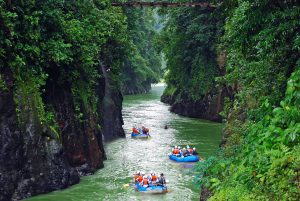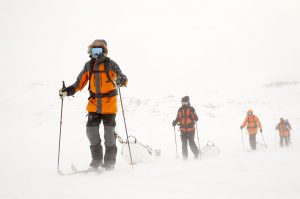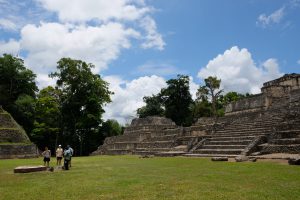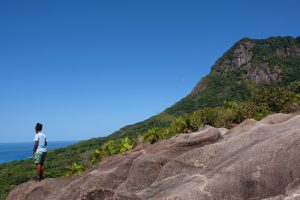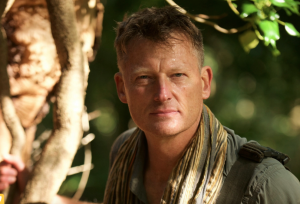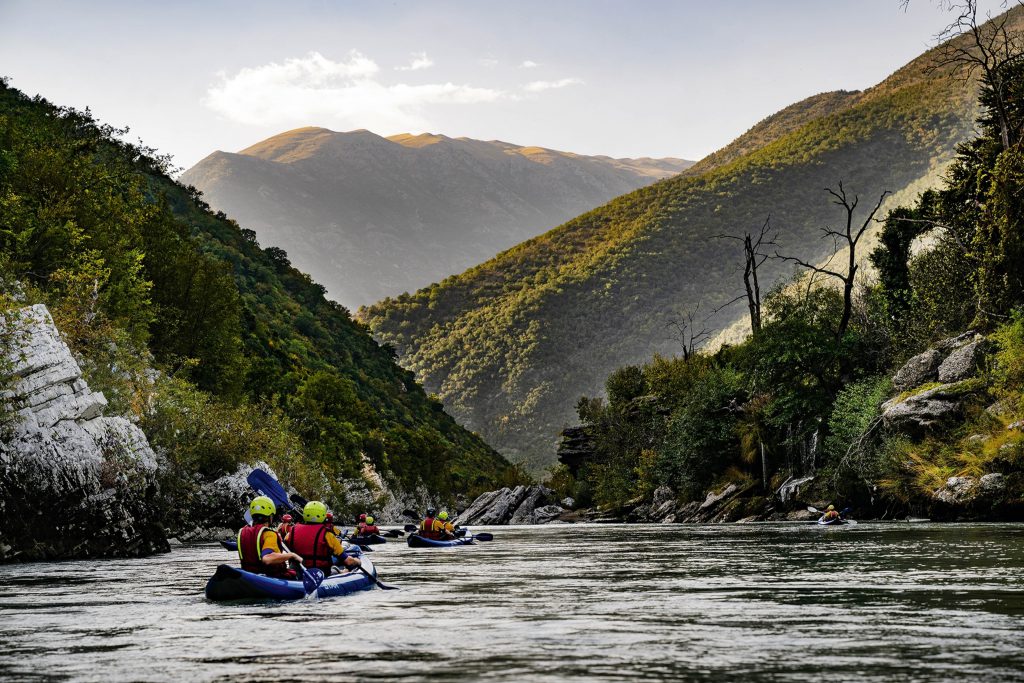
A new generation of travel entrepreneurs is putting the bucolic southern regions of Albania on the map, offering opportunities to dine with shepherds, dip into hot springs and raft in Europe’s first wild river national park.
Read online at nationalgeographic.com
At the end of a long, dry summer, presided over by cloudless skies, the rapids of the mighty Vjosa have calmed and quietened. Which suits me just fine, sitting as I am in a kayak navigating the ancient sweep of Këlcyrë Gorge.
The corridor of gushing waterfalls that earned it the moniker ‘Paradise of a Thousand Springs’ is equally languorous: rivulets rake the stone walls, trickling down to the water basin through gravity-defying profusions of vegetation and resolute, twisted trees.
This is one of Europe’s last wild rivers — practically the only major waterway on the continent unsullied by dams — and a long battle to preserve its natural rhythm and important ecosystems from developers has finally been won. I dip my paddle into the Vjosa’s turquoise meltwaters, part of an unbroken rush from Greece’s Pindus Mountains to the Albanian coastal city of Vlorë. And as I steer the nose of my kayak through picturesque channels, I start to understand why this virgin river, eulogised in poetry and songs over centuries, matters so much to locals, and why a multi-year campaign to preserve it resonated with the likes of clothing brand Patagonia and even actor Leonardo DiCaprio. The 168-mile Vjosa was declared Europe’s first wild river national park in March 2023. Today, the forward-looking travel guides who rallied to help save the country’s ‘blue heart’ wear this victory like a badge of honour.
“A politician once challenged me: ‘Who do you think you are, the father of the river?’” rafting guide Zamo Spathara says earnestly the next day, recounting his part in the fight. “I replied truthfully: ‘No, rivers aren’t mine or yours. They’re for everyone.’” I’m back on the Vjosa, part of a five-night active adventure itinerary in southern Albania organised by Much Better Adventures, and this time the fierce campaigner — and the father of Albanian white-water rafting — is at the rear of an inflatable craft.
Suntanned and stocky, he’s throwing his weight into steering, and shouting directions as our crew of eight clumsily attempt to paddle in-sync. One of hundreds of thousands to leave Albania after the fall of the communist regime in 1991, Zamo found he couldn’t stay away. In the late 1990s, he returned from running rafting tours in Italy to introduce the sport to his home country.
He established routes through unexplored waterways, founded an adventure company, opened a hotel and eventually created the Albanian Rafting Federation. “People thought I was mad, but I didn’t listen,” Zamo admits. “I knew my country was beautiful; I wanted to build something here. I wanted to convince foreigners we were more than the dark things people talked about.” As our raft ricochets down a grade three rapid and scuttles into a shaft of glorious sunshine, we all whoop and raise our oars to the middle in a clunky high-five. His work seems to be paying off.
It may be the tail end of a busy high season, but Zamo and his team of young rafting experts exude energy on our small-group tour of Albania’s mountainous backcountry, which kicked off and will end in the capital, Tirana. The guides have a lot to be happy about, too: visitor arrivals to Albania are soaring. Figures for the first half of 2023 show a 30% increase in travellers from the same period a year before. Outdated stereotypes of criminality and blood feuds are being replaced with viral social media posts showing pristine Adriatic beaches, gorgeous Ottoman relics and fresh Mediterranean food. If Albania was once Europe’s best-kept travel secret, word is now spreading.
Travelling between little-known beauty spots in the country’s south is one of the joys of the itinerary. While Albania has invested heavily in new infrastructure over recent years, my guides prefer tackling the old back roads in hardy, open-sided Land Rovers. Ali Spathara, a relative of Zamo’s in his early 20s — and a member of Albania’s national rafting team — is at the wheel later that day as we careen north along a dirt road, one of many built by Italian occupiers during the Second World War. “I’ve been rafting since I was four, and driving since I was 12. I sometimes don’t know which I’m better at,” he says with trademark swagger as he expertly brings us round a sharp, precipitous bend, sending a spray of dust and gravel into the warm, pine-scented air.
The valleys out here are lush, vast and unspoiled, with rows of serrated peaks misty on the horizon. Small, flowering villages punctuate the hours spent bumping through the mountains. It’s only when we pass the ruins of a communist-era labour camp that I understand the isolation I’m currently enjoying would once have sealed in prisoners, prohibiting any thought of escape. The reign of dictator Enver Hoxha — who ruled the country from 1944 until his death in 1985 — still casts a long shadow over modern Albania. The guides are happy to explain his paranoia-induced construction of up to 750,000 military bunkers, which still litter the landscape, and his bizarre criminalisation of men’s beards. But the human cost is skirted around more gingerly: the execution of over 25,000 people, the confiscation of all property, the banning of religious worship, the mass surveillance, the torture.
As dusk falls, we pile out of the 4WD convoy, stretch, and take in our surroundings. Ali’s forded a low tributary of the Vjosa to park in the shadow of the high-arched Ottoman-era Kadiut Bridge. We’re in the town of Bënja, close to the sleepy holiday resort of Përmet where we’ll stay the night — it’s known as the ‘City of Roses’ for being Albania’s cleanest and greenest community. There’s a faint smell of sulphur on the breeze.
We use the glow of the headlights to shuffle into our swimwear and grab local Korça beers from the car before sinking into the silky waters of a geothermal pool, backed by forest. Steam rises into the night, bats swoop overhead and a group of a dozen disparate travellers, who just a few days ago were strangers, together watch the moon rise from the dark tree line, moving through twinkling constellations towards the banner of the Milky Way.
City of a thousand windows
It’s in the UNESCO-inscribed city of Berat, where a spectacularly preserved Ottoman old town tumbles down two steep banks to meet the curve of the River Osum, that I learn about Albanian hospitality. The tradition of besa holds strong , affable historical guide Bona Xhafa explains as we ascend through higgledy-piggledy lanes towards the lofty crenellations of Berat Castle. It’s an oath of tolerance and generosity, baked into the culture over millennia of occupation and assimilation. “We were the only [occupied] European country to have a larger Jewish population after the Second World War,” she says. “In Berat, many families and officials risked their lives to hide refugees.”
Nowhere can the layers of Albanian history be seen more clearly than in this hilltop citadel. Remnants of important churches and mosques are testament to the co-mingling of Illyrian, Roman, Byzantine and Ottoman cultures over 2,400 years. Today, a community of 300 people make this one of Europe’s last inhabited fortresses; cobbled alleys reveal ancient stone houses, guesthouses and cafes wrapped in flowering vines. “There’s so much history, we could spend days here and it would still be a whistlestop tour,” Bona says apologetically. Early 14th-century frescoes are among the many treasures housed here, and from the highest rampart, over 600 feet up, the view stretches for miles. It’s here I linger longest, taking in the old town below and the hulking massifs framing it — which local legend says were once warring twin giants, now immortalised in mountain form.
The next morning, our group drives out for a day of hiking in the foothills of the highest peak, Mount Tomorr, whose saw-tooth crown threatens to pierce the blue sky at over 7,900 feet. “This has always been a holy mountain. A place to ask for what you need,” Zamo tells me, as the group scrambles downhill towards a grassy saddle, some hours into the trek. The sight that meets us elicits murmurs of joy: sheepskins and woven blankets have been laid out for a picnic amid the heather, and sizzling cuts of lamb are cooking on a campfire. For a moment, tired as I am from the hike, I wonder if I’ve wished it into being.
Our host is local shepherd Durim Azizaj, whose pastures lie not far from us in the lower valley. He gives us a toothy grin as we settle down and whips out an unlabelled bottle of the local moonshine, raki — an eye-watering brandy that we’re encouraged to swig in the name of friendship. Plates are piled mountain-high with all manner fresh salads and vegetables baked with spices and stuffed with cheese.

In truth, I’m still full from breakfast. Earlier that morning at Zamo’s hotel, the stately Castle Park in Berat, his wife Alma had told me about the network of producers they’d fostered. “Everything you’ll eat with us is local and fresh, the opposite of fast food,” she said, plying me with hot bread, jams, eggs and olives. She explained how, even in the early days of tourism to Berat, she and Zamo wanted to include and uplift local villagers. “When I first asked people from the mountains to help feed and entertain our guests, they said we only have simple things — they thought foreigners wanted expensive chocolate and Coca Cola!” She added, “I told them you wanted to hike, to hear their stories and songs. At first, they couldn’t understand. They’d lost pride in what they had.”
Zamo and Alma have been hosting travellers in Berat for two decades and working with Much Better Adventures since 2017 — and in that time Durim has certainly got in the swing of hosting on Mount Tomorr. A speaker is produced and tinny Albanian folk music floods our picnic clearing: it’s time to dance. Following Durim’s lead, we all lock arms in a circle and kick and step to the drumbeat, which gets faster and faster. Highly amused, he breaks away to offer up a toast, translated by guide Endri Hoxha: “He thanks you for coming to his part of the mountain, and he hopes you enjoyed this mountain food. He’s thanking Zamo, too, for bringing so many people to this beautiful place. Gëzuar!”
We trek on, through sun-dappled woodlands, to a soundtrack of distant goat bells, until we reach the remote village of Qafë Dardhë and rest on the grassy terrace of a small cafe. After 25 years working in Greece, owner Batjar Koci returned to his childhood home in 2021 to restore the dwindling rural community; stone cottages, abandoned during the post-communist exodus to the cities or abroad, are being turned into smart guest rooms for visiting hikers. “Abroad, you can only work, only be a number,” he tells me as we tour the beehives, vegetable gardens and the small primary school where he learned to read. “But in Albania, you can start something of your own.”
I leave with two giant tomatoes in my backpack, gifts Batjar insists I enjoy; they join the jar of honey Alma pressed into my hands earlier. On the drive back to Berat, bumping through wild orchards, Zamo pulls over to pluck plump pomegranates from a bough, passing them among his passengers. “We just want to share what we have,” he says.
Tides of change
Our final days are packed with more action, more flavour and more fresh air than most months back home. We tour deep into the dark belly of Black Cave in Pëllumbas, our torches lighting up glossy stalagmites and colonies of bats; and explore the town of Tepelenë in the footsteps of Lord Byron, who stayed at the Ottoman court of Ali Pasha near here in the early 19th century. And a memorable evening is spent discovering Albanian wines at Çobo Winery on the outskirts of Berat. “When my father and uncle wanted to focus on reviving native Albanian grapes, on rebuilding what their grandfather lost when the family vineyard was confiscated by the communist cooperatives, people said: ‘Don’t bother, Albania is only good for making raki,’” Ermira Çobo tells us, pouring out the first vintage in her family’s large farmhouse tasting room. A rich red from the Vlosh grape, aged for three years in French and Italian oak barrels, swirls in my glass. There are heady notes of rhubarb and cinnamon. It’s divine.

To round off the evening, she pops the cork on a sparkling white, made from the local Berat grape Puls. “We named this Shëndeverë, the most beautiful Albanian word. It speaks of summer, that feeling when you’re so healthy and happy you’re almost dizzy.” I’ve come to learn there’s poetry woven into so much of Albanian life and lore; it seems apt the country would coin a term to express a joy nurtured by the seasons, felt deep in the soul.
Pouring passion into the business since 1994, Ermira’s family produces 100,000 bottles a year. And although the market remains mostly domestic, she says Albanian wines are finally starting to gain recognition abroad, too. “Winemaking has been here since before the Romans, our terroir is perfect. It’s just been neglected,” she adds as she bids us goodnight.
The itinerary’s headline attraction has been left until last: the three-million-year-old Osumi Canyon, which tears into southern Albania for over 16 miles and plunges to depths of up to 400 feet. It’s a place Zamo had earlier described as looking like “Lord of the Rings, Tarzan and Avatar combined”. Under the leadership of Endri, another protégé of Zamo’s on the national rafting team, we don wetsuits, life jackets and hard hats and descend on rough paths into the rift. At the bottom, I splash into icy, knee-deep water and absorb the sheer scale of the striated limestone walls, before wading towards the nearest island.
During the winter rains and spring thaw, the canyon floods, drawing whitewater rafters until the early summer. But later in the year, when the parched river runs low, this particular three-mile course is perfect for an aquatic hike, with rocky outcrops to dive off and pounding waterfalls to swim beneath. “Zamo went to war to save this place,” Endri says. “Before the Vjosa was threatened and the world got involved, Zamo was here fighting against dam projects that were popping up like mushrooms. He got politicians, broadcasters and journalists involved in any way he could to halt the development plans,” she continues. “He was worried everything beautiful in Albania would be ruined, and that tourism here would be killed.” Knowing this, the timeless beauty of the place takes on new resonance — it conceals the hard struggles of locals to keep it this way.
Part of Zamo’s life’s work has been convincing Albanians of the value of their natural assets, and selling them on his belief that tourism can restore the country’s economic prospects more equitably and sustainably than allowing industry to take over the countryside. “People thought rivers were just a place to throw rubbish. That’s really changing now,” he had told me, back on Mount Timorr. “When communism ended, we felt we had nothing. But tourism has improved our relationship to nature — and brought us pride, too.”
His passion for sharing the wild interior has proved utterly infectious over the past week, and I doubt I’ll ever look at a waterway the same. As I clamber up a ledge and leap into the clean, eddying currents below, it strikes me that Albania may be one of the last places left in Europe where discovery feels truly unscripted — where the charm of the country and the generosity of its people can take your breath away, as sure as diving into a river.
Published in the June 2024 issue of National Geographic Traveller (UK)




